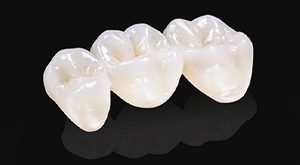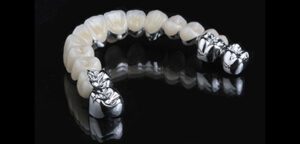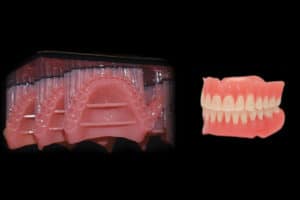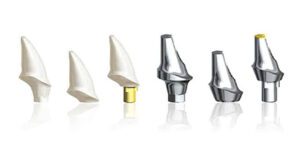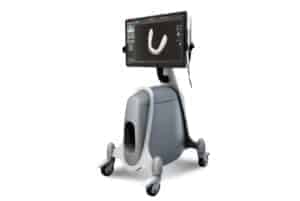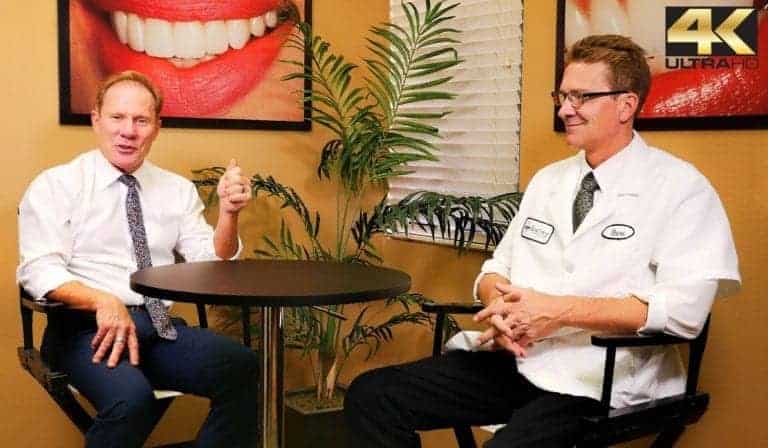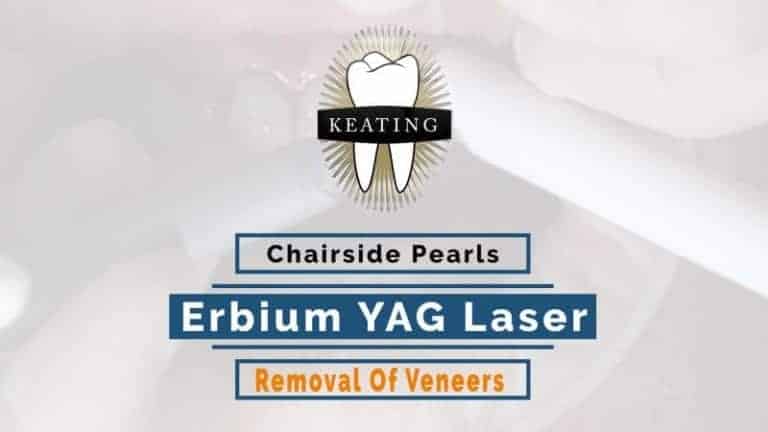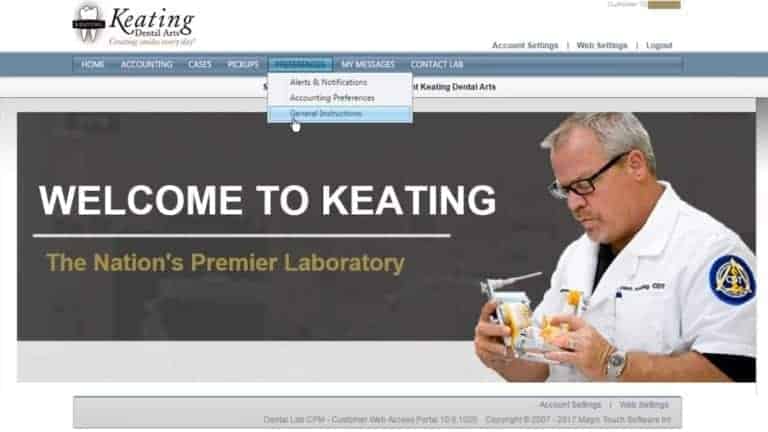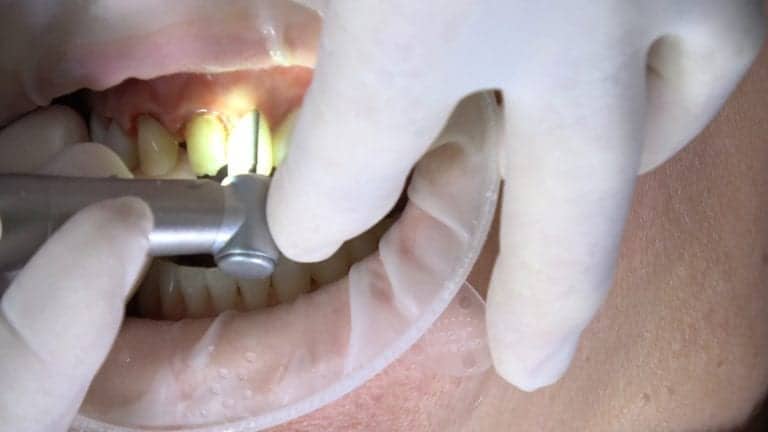October 29 2015 – Once again another dynamic “Dental Up” Podcast with DR. H! This time, Dr. Hornbrook recruited one of his favorite and most reputable implant experts from Keating Dental Lab “Steve Tapie”. Besides being an implant “jack of all trades”, Steve leads with remarkable personal ethics and values. He’s the “guy” who will always takes the time out of his day to troubleshoot implant solutions with you as the dental industry moves into the dental implant revolution of 2016.
I had a chance to sit down with Steve and David before the interview as they talked some seriously technical implant information that most dental labs do not usually give thier clients and partnerships. The way they explain these custom abutments, implant orientation and common problems and solutions with bite registrations made it pretty cut and dry for even a “director of cinematography” to comprehend. Not saying I am going to go out and start putting Nobel Procera FCZ’s in peoples faces, but may very well consider some options for me personally with the advancement of these amazing dental implant products.
This nice little “Short Film” on dental implants, Clinican/Lab communication and what you need to know about “implants” really lays down some quality knowledge that is really directed towards the dentists for furthering their knowledge of implant systems, custom abutments and communicating with everyone across the board on this amazing process. -Timothy Patrick (DP/Creative Director)
Subscribe and download the DENTAL UP Podcast: http://itunes.com/podcast/dentalup
Visit the Keating Implant Technology page: https://keatingdentallab.com/services/implants
The Best DENTAL CONTENT in the industry: https://keatingdentallab.com/dental-up
Video Transcript:
Dr. Hornbrook: Hello. I’m Dr. David Hornbrook, the clinical director of education and technology here at Keating Dental Lab in Irvine, California. We’re here today for another one of our weekly podcast under Dental Up. We’re here with Steve. Thanks for meeting here Steve. Steve is the implant specialist here at Keating. I spent some time to interview you about two months ago.
Steve Tapie: Yes.
Dr. Hornbrook: Early on in our podcast. What I thought was originally going to be, kind of, a boring subject, it was very cool and fun to talk about the things that you encounter and the problems doctors have as they’re setting implants. I’ve been here now at Keating for eight months. As I walk around the different departments, you’re department is the one with all the cases on cards that the doctors need call back. Sometimes it’s whether the implant not be placed in the right spot, you’re not sure what kind of implant it is, you’re not sure if it’s seated right, question about restorative and there’s so many options now. This is going to be a little bit of a review for people that were listeners before but I’d like for you to talk a little bit about the common problems. We saw some cases on the floor today. Some of the common problems that clinicians are facing with the implants that they send.
Steve Tapie: A lot of the times, we have the orientation issues when a doctor’s taking the transfer assembly, and they don’t take it by wing, or radiograph to their finest seat, and that’s one of the main problems that we have, is the orientation being off. Another thing is, is that we get a lot of problems with the bite registration, [inaudible 00:01:36] they use an open tray or close tray technique. If the use the close tray technique, use a triple tray, which a triple tray we kind of want to lean against.
Dr. Hornbrook: Right.
Steve Tapie: It defeats the purpose of having the transfer assembly, and then biting into it to get occlusion. It’s a little taller than the adjacent “T” so that kind of defeats the purpose. We like to get a full arch impression with the transfer assembly and like we talked about before, is blocking [00:02:00] out the screw hole so it’s not into the impression. Of course, I’m assembling a lot of them under the scope.
Dr. Hornbrook: Right.
Steve Tapie: To make sure we have an definitive seat, and then if I see anything different, we always call and touch base with the clinician and let them know, doctor this an area that we may be, something we want to, of concern.
Dr. Hornbrook: Okay.
Steve Tapie: So we do.
Dr. Hornbrook: I’m going to put you on the spot here a little bit, and you can plead the fifth if need to. You know if I had this conversations where, the cases, where you’ll say, “Oh, this implant … ” or “I hate working with this particular implant.” You can’t get parts, or the parts aren’t as good, where, “I love working with this.” If you had to tell me, If I called you and say, “Hey, I’ve got this very cool case coming up, I haven’t ordered the implant placement yet from the surgeon … “
Steve Tapie: Hmm.
Dr. Hornbrook: It’s a mold, or a posterior tooth. What dental implant system should I tell the surgeon to use, or what would be some of your top choices?
Steve Tapie: A recommendation of what systems … of course we do all the systems here, and if we can’t find them, I’ll track them down. Our number one, two and three, let’s say, would probably be Nobel Biocare dental Implants, that’s one of the top three. Zimmer also, is another one that is very common. We do have our BioHorizon’s, which are also very common, but those are probably the three, and then of course Straumann, and 3i. That’s that top handful that we really do the majority of restorative on.
Dr. Hornbrook: The one thing that I think a lot of general dentists are listening, or watching, they send the case to neurosurgeon, or the periodontist, and they don’t specify an implant type.
Steve Tapie: Mm-hmm (affirmative)
Dr. Hornbrook: I had that problem. I ended up getting an implant, not part of the original treatment plan, and I wanted to do a hybrid abutment, and it turned out this particular implant company didn’t make that type of abutment. Which screwed my whole treatment plan because I had already told the patient this what were gonna do.
Steve Tapie: Right.
Dr. Hornbrook: Assuming, and so limitations as far, let’s talk about the best. [00:04:00] As far as, you getting an implant case from a dentist knowing that more than likely this implant company is going to have, probably, whatever you need. Whether it be a hybrid, whether it be a tie base, zirconia, metal, gold, [inaudible 00:04:15] Kind of the same order?
Steve Tapie: Yeah. It’s kind of the same order, of course Atlantis, and more than that, Atlantis, but Dentsply with the Astra’s, that’s another big one, also.
Dr. Hornbrook: Right. Right.
Steve Tapie: Usually where we start to run into troubles on the narrower fixtures. These 3.0’s that are coming out, because they’re so narrow, that you can’t really even, let’s say, what would be a NobelProcera abutment, or an Atlantis abutment, they don’t even have those platforms for those, or Nobel, yet for that. I’m sure they’re coming out with it, but it’s kind of where we’re, it’s catch 22, well we can do it but I need to go this route.
Dr. Hornbrook: Right.
Steve Tapie: I can get a tie insert, but maybe, like I just ran into where it asked, where it did not have, the 3.0, but I found the company that did make it.
Dr. Hornbrook: Okay.
Steve Tapie: That’s the crown that I showed you earlier today.
Dr. Hornbrook: Right.
Steve Tapie: That was the hybrid screw retained …
Dr. Hornbrook: Right. Yeah, it’s cool, it looked awesome.
Steve Tapie: It looked nice.
Dr. Hornbrook: Great option to …
Steve Tapie: I, let’s say, did some little engineering, a little think process on it, and I was like, okay, I can make this work. I called the doctor and I said, “Doctor we can’t … this isn’t going to be an Astra abutment, but I can find one that will work in this situation.” He was okay with it.
Dr. Hornbrook: Yeah.
Steve Tapie: As long as we’re upfront, the communication between the dental admin and doctor. Things usually work out fine.
Dr. Hornbrook: Yeah, and I think that’s a huge benefit, a doctor working with Keating, or with you. We do so many implants that, I mean, I’m a senior; your catalog’s almost like going to the auto parts store, and they’ve got all these catalogs of different screws, and bolts, and batteries, and clutches.
Steve Tapie: It’s funny, I had them in my miscellaneous drawer which just had, some off brands became less and less because these are becoming more mainstream. Mainstream, I mean, there’s [inaudible 00:05:57] actually bought a portion of them. [00:06:00] There’s these companies are coming out, that you really have to stay on top of it.
Dr. Hornbrook: Let’s go the other route. Is there any particular brands, or manufacturers, of implants that you don’t really like to work with? Meaning, it’s difficult to find parts, parts maybe don’t fit quite as good as you would like, or limited resource options?
Steve Tapie: There’s like that one company I just mentioned, the Neodentist, kind of new one out there. There’s some that you have your online implant companies, like the Blue Sky, which is an online, which is harder to … they have the array of parts you just have to go online to order it where there’s no communication with, let’s say, with calling, I mean, they have a technical support team but it’s just, I like to talk to people when I’m ordering my parts, and I want to verify that. I don’t want to get a jumbled array of parts, and go, ugh, you know. This is the wrong- because I clicked the wrong button, or they sent the wrong part. Which I’ve gotten from times, that they actually sent the wrong part.
Dr. Hornbrook: Right.
Steve Tapie: Hiossen is something that we have to fax over our order to them, and I can’t really tell someone …
Dr. Hornbrook: You can’t call in?
Steve Tapie: No, and I like to have that communication. I want them to read of what I had ordered and we apply P.O numbers to make sure that part goes to that case, the Hiossen, and the Blue Sky Bio’s and, but they’re becoming more and more mainstream, it’s amazing. You have practices that are trying to save some money, and a lot of these fixtures are becoming where the companies are actually supplying, like with the Implant Direct. They almost have every line out there, with the Nobel, and the Zimmer, and the Straumann, and the- they actually have those fixtures.
Dr. Hornbrook: Yeah, so they’re clones that you can go to them and buy a less expensive, I’m not gonna say cheaper, but less expensive version that is still high enough quality that we feel comfortable with.
Steve Tapie: Sure. Yeah, yeah. Implant Direct is a company that we work with, but there’s a lot off, these smaller companies that trying to really push. [00:08:00] I have, Sterngold coming out now, they’re trying to push, above incident, I mean, my opinion, they’re a little late in the game. They’re trying. Everybody’s trying to get their foot in the door. Which is, it’s a profitable market, but these main companies with Zimmer, 3i, they got bought out and so they’re merging together. These big companies are starting to get even bigger.
Dr. Hornbrook: Are you seeing any problems with, you know just like everything in our world, where you can get things cheaper from China, or the Philippines, and nothing against China or the Philippines, or their people; lots of times it’s equal quality and lots of times it’s not equal quality.
Steve Tapie: Mm-hmm (affirmative)
Dr. Hornbrook: Are you seeing problems with some of these after market parts that … ?
Steve Tapie: I haven’t seen problems, per se, but we work at the Diamond [inaudible 00:08:46] it’s a company that we actually work with, and we’ve been working with them since the labs been open. In Keating, we try to stay with quality of course, and this is a company that is up the street, and has great communication. We haven’t had any issues with the fit and the platforms, they’re really a good company to work with. Henry Schein came out with the [inaudible 00:09:04] which has a catalog, and they have like a really large array of options. It’s sometimes where you get the analogs which we talked about before, you don’t have to send with the case, and so it can be very expensive at times. Up to $35 for per an analog. We supply that, so just so you know you don’t have to send the analog with you case, because it gets pricey, cut down the bottom line, just like, sometimes we can utilize these companies and do stock titanium abutment which could be, save, you know, a couple hundred dollar, hundred case.
Dr. Hornbrook: Right.
Steve Tapie: Depending on how many units. I always call, let’s say, the doctor, and say, this isn’t a great location, I can save you some money by doing a stock titanium.
Dr. Hornbrook: Okay.
Steve Tapie: We can save you some money. But, again, we know the warranty’s that a lot of these bigger brands have, which we had the discussion a few days ago about, or yesterday …
Dr. Hornbrook: Mm-hmm (affirmative), right, yeah. Yeah, we met, we just talked about that before we went on air. We met with Nobel, and Nobel is 15-20 miles from here.
Steve Tapie: Right.
Dr. Hornbrook: [00:10:00] They’re coming out with some very cool things.
Steve Tapie: They are. Yeah, they have some very cool things on the market now.
Dr. Hornbrook: Yeah.
Steve Tapie: With the angulated screw channel, and the full “xcz”. We’ve been dabbling in that. Which we’re trying to get more and more doctors to utilize these products. Even though they’re new, they’ve got the research, and the RND, on their end, and they’re actually pretty nice.
Dr. Hornbrook: Yeah, and I think a lot of doctors, at least in my lectures, we had this conversation yesterday, was; a lot of doctors don’t know that this stuff is out there, one is the angled screw.
Steve Tapie: Right.
Dr. Hornbrook: The channel. I mean, that’s amazing, to be for us to put that access hole within 25 degrees of actually long access the implant, and not compromise the integrity. All of a sudden, we’re getting screw holes in the center of the crown versus on a cusp tip, where we used to have to do it in the past. I think if doctors understand that these things are available, and then surgeons can place the implants based on bone, instead of just our restorative. It’s always been that compromised. Here’s the bone, this is where I want the crown, and the two do not meet.
Steve Tapie: That’s where we have to come to a happy medium. It becomes a little challenging, but as long as we’re in communication with the clinician and we let them know, this is where we’re at with this case, and this is where it’s gonna wind up. It’s basically, by the time the practice, the doctor gets it, it’s a little late to go back. I’ve seen some really nice outcomes out of doing some, sometimes we’ll do a custom UCLA, where the implant will literally is coming straight out. We did a UCLA in the case, and it actually turned out really nice.
Dr. Hornbrook: Yeah.
Steve Tapie: We got some great technicians at Keating. We have a lot of experience here. We’ve done tens of thousands of implants and a lot with all our other products we do here. Of course, we launched our new website.
Dr. Hornbrook: Mm-hmm (affirmative)
Steve Tapie: There’s a lot of information on there.
Dr. Hornbrook: There is a lot of information on there.
Steve Tapie: [00:12:00] We got videos of you on there, and some other of the managers here.
Dr. Hornbrook: Yeah. I’m very excited about it.
Steve Tapie: It’s a great resource for doctors to come to.
Dr. Hornbrook: Yeah, absolutely it is. I look at you out there, you’re assembling parts, and you got a great team there, that’s doing the implant team. But you’re on the phone a lot. Those are all the carts around you, with all the case. What are some of the primary questions, what would you anticipate; you’re gonna go back, and before the days over, there’s gonna be two or three things that are gonna come out, that are asked more often than …
Steve Tapie: A lot of them. [inaudible 00:12:33] filling out the Rx form a lot of them will say, that the doctor or the patient, they don’t really want to know where they’re going with the case. I got a better idea, once this poured up I can say, “Okay, well what does the patient want. What does the doctor recommend we do. We can go for strength, aesthetics, maybe we can lean them towards the “H” abutment. Basically, until I see the imprint, or the model, in front of me, then I can better judge. All of it is basically, I get calls of what do you think I should do here?
Dr. Hornbrook: Yeah.
Steve Tapie: I look at the patient and [inaudible 00:13:06] them. Do we need to go for titanium, or gold hue in the anterior because he’s just hitting so hard. It could be a cusp hit, and I’ll go, yeah, let’s go with the titanium.
Dr. Hornbrook: Yeah.
Steve Tapie: We got the E-Max, the PFM, the [inaudible 00:13:20] and now we’re doing the [crosstalk 00:13:23] aesthetic, which is, I’ve seen some and they look very, very nice.
Dr. Hornbrook: Yeah, they look like E-Max.
Steve Tapie: Yeah, so that’s another thing. With our R & D here that we try to do, we need to keep up with the times, that’s a great product. We’re trying to do more and more of them. This is where we can actually use the gold hue to block out that titanium core, and then put it in the anterior. A lot of the calls are, besides the easy date calls, you know, “I need more time.”
Dr. Hornbrook: Yeah.
Steve Tapie: A lot of the calls we can’t really do, or it’s not offered. Let’s say they want to do a zirconium abutment, and it’s a tissue level Straun, well we can do it through Atlantis, but they might want a Straun, Straumann doesn’t do it, [00:14:00] or 3i doesn’t do it. I’d have to negotiate with the different companies that we work with to get the doc what they want. It’s a lot of just product and abutment selection. I can get one case, and I can go about ten different ways.
Dr. Hornbrook: Yeah.
Steve Tapie: You know, so it’s really what the doctor wants. I asked them, what do they expect? What does the patient expect?
Dr. Hornbrook: Yeah.
Steve Tapie: You know, and then, and we go from there.
Dr. Hornbrook: Yeah, and you know, the implant department in the world of dentistry is still one of the not very well understood by the clinician, the average restorative general dentist.
Steve Tapie: Mm-hmm (affirmative)
Dr. Hornbrook: You know, we’re getting prescriptions all the time, all ceramic crown, 2 number 30, gold on this, and the dentist feels comfortable enough to be able to say, I’ve got a crown prep, I’ve done thousands before, I’m gonna get this particular crown, I’m gonna cement it.
Steve Tapie: Mm-hmm (affirmative)
Dr. Hornbrook: But implants, where they’re changing so much …
Steve Tapie: Right.
Dr. Hornbrook: You know, platform switching, and …
Steve Tapie: That’s … yeah.
Dr. Hornbrook: You know, metal bases on tooth collared abutments.
Steve Tapie: Right.
Dr. Hornbrook: You’re given advice. I see those prescription … call me after [crosstalk 00:15:00] It’s like wait a minute that’s not a prescription, well it kind of is.
Steve Tapie: Yeah, it is, but, it’s like, you know, until you get the model port up of course the clinician he or she knows what it looks like, until you uncover the screw you really don’t know what you’re getting into. Then, of course, you just take the fixture level impression and send it in. That’s what part of my job here is, to help move the case along in the direction that is healthy for the patient, and satisfactory for the doctor. The end result is, is that, you know, we know, the patient is a walking billboard for your practice and in turn a happy doctor we get referrals from, talk about it, it’s a win win for everybody. That’s what we try to do here. It’s really not, send a case in, and but if it specifically says I want a titanium abutment, [inaudible 00:15:47] crown, we just fill the forms out and along it goes. A lot of the times I just like to touch base with the doctor, rather than you know, there’s sending cases in I’ll just give them a call, and say, “Hey, how are they going, how are things looking?” [00:16:00]
Dr. Hornbrook: Yeah, and a lot of these cases, because once, insurance doesn’t cover them. The patient may have invested 10’s of thousands of dollars, on multi-appointment plans, so in that case we saw today …
Steve Tapie: Today, yes.
Dr. Hornbrook: Where the patients already into this for 30 or 40 thousand dollars.
Steve Tapie: Sure, yeah.
Dr. Hornbrook: Things like taking a bite.
Steve Tapie: Mm-hmm (affirmative)
Dr. Hornbrook: Taking a bite, using a verification jig, utilizing your expertise to make sure that this case, as a dentist, they may be charging 50 grand for a case like this, or even if it’s $5000, it’s still a lot of money, and to make sure that it’s in the least amount of visits for the patient, for the dentist, as possible, and still yield a great result. I think that’s what we can do to help the doctors, is, this is what you need to do next.
Steve Tapie: Mm-hmm (affirmative)
Dr. Hornbrook: Then this, and this and you’re gonna move [crosstalk 00:16:50]
Steve Tapie: Yeah, we can try to do everything by the book, in the specific orders and there’s always issues that you’ll have. That’s why we have to have the communication, and off the first call it’s gonna be, we need to this. Rather than just go, like you said, they’re in it for 10’s of thousands of dollars sometimes, [inaudible 00:17:11] bridges, and now they’re getting very anxious. They want to get their teeth in the mouth. They’ve done all the hard work, and now they think this is the easy part. Well, actually, it’s all- nothing’s easy when we’re coming to this. To make it a successful outcome there’s certain things we like to put in place, and even when we do put those in place it still becomes challenging.
Like we talked about that case, and I talked to the doctor, we’re probably going to move forward with the suggestions that you gave. Which was great. Sometimes I can’t wait until you’re here [crosstalk 00:17:43] and walk around the lab, and then all of a sudden, I go, because I have a few questions I need to ask you.
Dr. Hornbrook: Right.
Steve Tapie: I wait, I hold these cases off, well I need to …
Dr. Hornbrook: You can always take photos and email me.
Steve Tapie: I know, I’m gonna start doing that.
Dr. Hornbrook: Some beach in Mexico somewhere.
Steve Tapie: Right, that would be …
Dr. Hornbrook: I may not answer them right away, but …
Steve Tapie: Right, but it’s great having you here though, because some of these [00:18:00] cases, it’s great having another opinion, I mean, we got you here, Brandon here, there’s a lot of talented managers around the floor, and they’re also huge help, in situations like that, where I’m, kind of, don’t really sleep well at night, because I’m trying to over think, or, you know …
Dr. Hornbrook: And the case is due tomorrow.
Steve Tapie: Well, yeah, I try not to do that. It’s great having a lot of talent around.
Dr. Hornbrook: Yeah, it is nice. It’s a good pool of people too, educated pool. Are you seeing many implant abutment one piece, [crosstalk 00:18:35] like Bicon’s and there’s, [inaudible 00:18:37] or zirconia, are you seeing many of those?
Steve Tapie: The doctor will just put it in [crosstalk 00:18:44] Nobel and Straumann have them, Hiossen has them, where yeah, you can just go ahead, and screw them in, and take out a [inaudible 00:18:55] cap and pressure. [crosstalk 00:18:57]
Dr. Hornbrook: Are you seeing [crosstalk 00:18:59]
Steve Tapie: Yeah, they come around, yeah they do.
Dr. Hornbrook: Okay.
Steve Tapie: You know, a few a day. It’s not too common, but they really have to be placed in an ideal location though, unless, or we’re modifying the abutment that’s in the patients mouth, which basically counts like a reduction coping. Some doctors, they’re sending them in. Yeah.
Dr. Hornbrook: Yeah, not in the east coast. They use a lot of Bicon, which we don’t see a whole lot on the west coast. It’s kind of an east coast west coast thing.
Steve Tapie: Yeah, not my favorite.
Dr. Hornbrook: Now, we finally got you to admit to one of his least favorite.
Steve Tapie: Yeah, well it’s a friction and doing, let’s say, a 3 and bridge where there’s no way to correctly have the orientation, you have to basically use the restoration as, or use a transparent [inaudible 00:19:40] to place, and then put the crown in, and you tap it in. It’s kind of hard with no orientation to lock it into.
Dr. Hornbrook: Right.
Steve Tapie: I’ve told doctors, I go, well use the bridge, place it in, push it in, and then you can tap it in. That’s really not one of my favorite.
Dr. Hornbrook: Yeah.
Steve Tapie: They’re a little …
Dr. Hornbrook: Yeah.
Steve Tapie: Kind of …
Dr. Hornbrook: [00:20:00] How many implants you think go out of here a week? Implant cases?
Steve Tapie: Let’s say, you know, 100 plus.
Dr. Hornbrook: Yeah.
Steve Tapie: Yeah. We’re about 4, 500 a month.
Dr. Hornbrook: Yep.
Steve Tapie: You know. Yeah. You know. Love to get more. You know. Of course.
Dr. Hornbrook: Yeah, absolutely.
Steve Tapie: We got the team behind us, so we could twice as much. With the Atlantis scanner, and the Nobel scanner, and the Straumann scanner, we got 3i that we can send them to. We can fill out the paperwork, submit them, and we got a great, Bernie Rego here, he does a lot, almost all the design abutments.
Dr. Hornbrook: Right.
Steve Tapie: He’s just catty corner to me.
Dr. Hornbrook: Yeah, and let’s talk about that. That’s again, something that came up yesterday. Something I talk about in my lecture a lot, is ten years ago we had these milling centers. We would send, as a laboratory, we would just send the model. Not digitally, send the model, and they would make, someone that really wasn’t in the world of dentistry, you know, they were a computer nerd, or a teenager that played Xbox, and was great on a computer, and they were designing our abutments.
Now, we’re designing all our abutments. Even if, even someone that we don’t know, like Atlantis.
Steve Tapie: Right.
Dr. Hornbrook: We send it, but we have total control of that.
Steve Tapie: We do. We can manipulate the angles, and the flares, and the tissues, you know, blanching of the tissue, there’s a lot of things on the software that we have now that we can do. Especially with Nobel, we have a little bit, we have the, you know, the 3Shape, we can manipulate the abutment specifically for that prescription that’s written. Some doctors want a supragingival on the lingual, some doctors want it …
Dr. Hornbrook: Like me!
Steve Tapie: Tissue, yes, tissue level, for easy cleaning of the cement, and stuff like that.
Dr. Hornbrook: Right.
Steve Tapie: Which you know, staying away from the cement issues with the [inaudible 00:21:37] and then sometimes they just wanted easy access. Of course when we’re doing the screw retained, a lot of screw retained restorations here too. Whether it be the UCLA one piece, and or, the Atlantis that we just submit here together in the lab.
Dr. Hornbrook: Yeah.
Steve Tapie: Of course, the “H” abutments, and the E-max crowns, and the list can go on and on. It’s never-ending. [00:22:00] That’s the great thing about being in a lab this size, it’s not too big where you get lost, but it’s small enough and we have …
Dr. Hornbrook: Well it’s big enough that we have access to technology too.
Steve Tapie: Yeah.
Dr. Hornbrook: As things change, you mentioned 3Shape, for us to buy a module in 3Shape for implants.
Steve Tapie: Mm-hmm (affirmative)
Dr. Hornbrook: You know, this lab can afford to do that. With a lot of labs, we’d be saying, you know, we can’t so let’s take an impression and send it off to [inaudible 00:22:23]
Steve Tapie: Right.
Dr. Hornbrook: Where do you see the future of digital and implants? Let’s move ahead in the future five years. When you’re sitting in your same desk, and probably, hopefully a newer chair.
Steve Tapie: Yeah, right.
Dr. Hornbrook: When you look at your team what do you think is gonna look different?
Steve Tapie: Maybe a lot more intraoral scanning of you know, looking at the scan bodies of the helo’s, or you the, you know, whatever they’re doing, and then they can submit that when they’re through, iTero or Trios or, there’s a lot of different companies out there, a million of them could get the model and the analog placed, basically, and then have it sent to us, then we fabricate the restoration. Sometimes, like iTero, you can actually do the scan, get the model and the abutment in the same day. iTero model will have a replica of the abutment, and then they send the abutment with the case. One comes from iTero one comes from Atlantis, we marry them up, and then they’re out the door. They probably more digital, intraoral scanning …
Dr. Hornbrook: And for those who don’t know where to scan, because there’s people saying, “I’m not really sure what that is.” Basically, it’s almost like a [inaudible 00:23:26] CAP, but a little bit bigger than the [inaudible 00:23:27] CAP that the dentist inserts. Then they scan over that. There’s markings on the top of that CAP, that basically says; what the implant is, how far down below the tissue it is.
Steve Tapie: Just gives you the orientation of it, and make sure it’s got to be orientated right or the whole case is a wash.
Dr. Hornbrook: Right.
Steve Tapie: The platform size, the depth, it gives you all the information you need.
Dr. Hornbrook: Yeah. Then you just scan it. With your drill scanner, you know, over ten on the market now, fifteen in all, then that gets sent to the corresponding companies, whether it’s 3M, or … [00:24:00]
Steve Tapie: iTero or …
Dr. Hornbrook: Or iTero, yeah, any of those.
Steve Tapie: Yeah, it could be.
Dr. Hornbrook: [inaudible 00:24:05] and then, we would get the models with the …
Steve Tapie: Mm-hmm (affirmative)
Dr. Hornbrook: The unlock in the epoxy or plastic model.
Steve Tapie: Right. iTero actually has the replica of the abutment. Atlantis and iTero are married together. What they do is, iTero will mill out the abutment that’s going to be sent with the case. There’s no analogs actually, in the iTero ones, which is interesting.
Dr. Hornbrook: Oh, okay. Interesting.
Steve Tapie: But that’s the, iTero works with 3i also. 3i, it’s kind of like the 3i scan bodies where you just take an impression of the [inaudible 00:24:35] CAP, which is scan [crosstalk 00:24:36] mapping of the abutment, the fixture, and then they just take an impression, and I’ll send that out to [inaudible 00:24:43] 3i [inaudible 00:24:44] to have the abutment fabricated, and it comes in, we give them the model, it comes in with the abutment and the model.
Dr. Hornbrook: Nice.
Steve Tapie: Yeah, so, there’s going to be a lot of that, I see. Hopefully, there’s going to a lot more implants because I think it’s a better restorative alternative rather then doing a 3 and a bridge, or a 4 in the bridge. Beautiful teeth you don’t want to destroy just to bridge it. If you put an implant in there it’s gonna be healthier for the patient and bone, and that’s keeping everything intact.
Dr. Hornbrook: Right.
Steve Tapie: I hope that we’ll see more implants. I really do.
Dr. Hornbrook: Yeah. Well I think we’re already starting to see that curve, right? I hope it goes astronomical. Again, it would be nice if insurance companies …
Steve Tapie: Right.
Dr. Hornbrook: Would at least help some of that of that payment for the patient. Insurance companies will pay for a bridge but not an implant which is absolutely ridiculous.
Steve Tapie: Yeah, I agree.
Dr. Hornbrook: Let’s kind of change our focus a little bit, because I still think there’s a huge disconnect between the general dentist and the surgeon. General dentist’s are very similar, they deal with a lot of specialists. Where they say, you know, there is a problem. Fix it, or get me to a point that I can fix it, but there’s no communication. As a general dentist, I come to you, with your knowledge as a restorative implant [inaudible 00:25:53] technician. I would say, you know, “What should I include in my conversation with my surgeon [00:26:00] before I send my patient?” Or, “Before the implants are placed, what kind of conversation should I have?”
Steve Tapie: I think it would be is, what is the patient looking for? What kind of restoration do they want? Are we just going for, let’s say, if we’re going for anterior region, let’s go, maybe, they want to do a zirconia abutment. Well it’s got to be placed in an ideal location, sometimes they’re leaning facially or lingually, and it’s just really got to be, I mean, I think the guided surgery would help a lot for placement of this, where we can get it on a scanner, we can kind of tell the oral surgeon this is where we would prefer it, but understanding we don’t have a radiograph of where the bone is, and the nerves are, and the sinus cavities that, where it’s not going to go.
I think that, it’s basically, what they need to talk about is with the outcome and where, what kind of abutment and what kind of restoration they want to do. You know, of course we want to place it in an ideal location.
Dr. Hornbrook: Right.
Steve Tapie: Not usually is the case, we can make surgical guides here with just a two millimeter [inaudible 00:26:54] level, and give an idea. Sometimes they don’t want us to put that sleeve in there, because, well they’re going, “Well I’m not married to this spot right now, so we’ll just do a hole.” Give him an idea, but I think it’s just a tough one, unless you can see the bone density and where you want to place it and then they kind of go from there. It’s very hard to see. I mean, where I want to put it is different from where the doctor wants to put it, and where the oral surgeon wants to put it. Everybody’s … I mean, I want to put it, of course, right dead smack center of the ridge. You know?
Dr. Hornbrook: Right? Yeah.
Steve Tapie: Sometimes we get them palpable, facial, distal. I mean I’ve had one case to where the doctor even had to adjust the transfer assembly so much because it was hitting the abutment tooth. He literally had to grind it to where it almost removed it, and I called him up, and I go, “Well what do we want to do?” I can’t get a, the fixture was almost leaning against …
Dr. Hornbrook: Right.
Steve Tapie: The root.
Dr. Hornbrook: I’ve had that in my practice too.
Steve Tapie: Yeah, so. So, it’s just communication. It’s just what we want to do. Of course, we want to see the best thing that’s for the patient, but sometimes we can’t, you know. I would think that [00:28:00] if we want to do, and it depends on the fixtures, because sometimes we can use that ASC that we discussed, with the twenty degree, or we could bring that back a little bit, to hit the bone, those are only four actives, the only, the Nobel Active is the only one that really offers that right now.
Dr. Hornbrook: Mm-hmm (affirmative)
Steve Tapie: I think in the future we may see more of these, for different platforms. Which I think would be great.
Dr. Hornbrook: Yeah, I think so too.
Steve Tapie: That’s a good question, and it’s a hard one to answer …
Dr. Hornbrook: I think just listening to you, and my relationship here at Keating that I, again being on both sides, the lab side and the dentist side, is exactly as you said, start with the end in mind. You have a conversation with your surgeon, this is our goal, this is what we want to do, we want it to be aesthetic, it’s part of smile line, we’d rather not have metal, I’d like screw retainer, or it doesn’t matter, right? Start with the end at mind, and then, that’s where I think a conversation with someone like you, so that we could determine what implant we’d like the surgeon to place. My surgeon uses about 4 or 5 different implants. Right? I honestly don’t always know how he decides. Sometimes he’ll get Astra, and sometimes it’s … I’m using mostly Nobel, or the surgeon is, I’m just [inaudible 00:29:13] mostly Nobel, but every once in awhile I get a Straumann or an Astra, and it’s like, why did the surgeon decide at that moment to do that. Lots of times I don’t know the answer.
Steve Tapie: Mm-hmm (affirmative)
Dr. Hornbrook: If it’s a problem maybe I would. But I think doctors finding what the outcome is, calling you and say, “Steve, listen. This is the outcome. This is kind of where [inaudible 00:29:32] ,what implant am I going to have more flexibility?”
Steve Tapie: Yeah, the diameter of it, and where he’s going for the bone too. I would say, I mean, we got the three [inaudible 00:29:43] we were talking about, and you know, a number seven and a number ten, well they have the 3.0’s or we can come for the 3.4 or the 3.5 so we want to get the narrower of course, because we to get the narrower abutment in there. I think going for, if it’s an immediate [00:30:00] implant going in there, so you know, usually they go for the bigger diameter ones. I mean, but I’ve seen some in the posterior range where they’re putting out, let’s say, a Zimmer 3.5 in a molar. That’s very small, it’s very hard to create a emergence profile when you get so small, you have to literally, unless it’s, and I’ve had it to where it’s that diameter and it’s at tissue level, and it should be a little bit deeper, so we can get a nice emergence.
We start being creative and trying to a do a ridge lap where some, I’ve talked to a lot of clinicians, and they do not like that. I don’t blame them, it’s tough to clean … and I go, “Well then this is going to be a, basically an [inaudible 00:30:38]” coming straight up from the fixture if we can’t do anything like that. I think selection is key, and it just depends on … and I’m sure the oral surgeon is thinking one thing as far bone density, and I need to get this diameter in here, and I can’t do that because the nerves right here, or the sinus is right here. I have to use a very short, you know, I mean, I’ve seen them from, they’re 5-11 millimeters. I mean, you can go crazy, as far as how deep you can go. But then they don’t go that deep to where it’s in the bones. It’s still, almost like a Straumann tissue level.
Like I said, it’s just something that can be, makes it more and more challenging I guess. We become more and more creative, and the outcome is usually satisfactory, if not great.
Dr. Hornbrook: Or better. Don’t limit yourself. [crosstalk 00:31:28] We want “A’s”.
Steve Tapie: If I could grade where they’re placed, it would be, you know … that’s …
Dr. Hornbrook: We always blame the surgeon.
Steve Tapie: It starts there.
Dr. Hornbrook: Yeah, we always blame the surgeon. Yeah we’re going to ahead and wrap up, that’s our 30 minutes. We call these “Treadmill Podcasts” because we just finished our 30 minutes on our treadmills. [crosstalk 00:31:48] I appreciate it.
Steve Tapie: Great, thanks.
Dr. Hornbrook: The time that you spent. You know my recommendation, again as a restorative dentist, and having the unique opportunity of working in a dental lab as well, that you know, there is a huge resource for you [00:32:00] as restorative dentist. You know, don’t put yourself on a pedestal, I’m a dentist I’m not going to call my laboratory or my [inaudible 00:32:07] for ideas to make the case better. You absolutely should. It’s a great resource for you. We can offer better dentistry then we’ve done in the past. Not only, do we have more information, whether it be digital dentistry, whether it be CT scans, or some kind of new technology. We’re doing better dentistry.
If you ever have any questions about anything, you can email him, you can email him X-rays. In fact, every time I do an implant I put the transfer post, the transfer coping in, I email it to him. Just so I can say, “Is this okay?” You know, most of the time I know it’s okay, but I want him to say, “Yeah, that’s fine.” It certainly gives me just a little bit more confidence that it’s in the right place and I’m going to have a final outcome that has good long term prognosis. Be sure to check out our other podcast at https://keatingdentallab.com/dental-up. We have some great educational videos, as Steve mentioned, we have some really good clinical tips on not only in implants but other restoratives.

